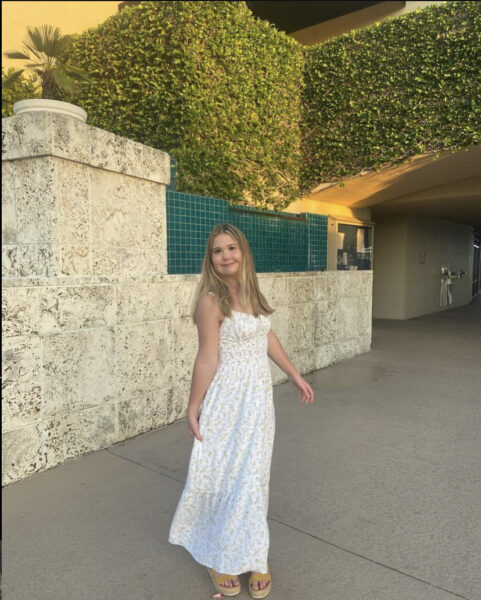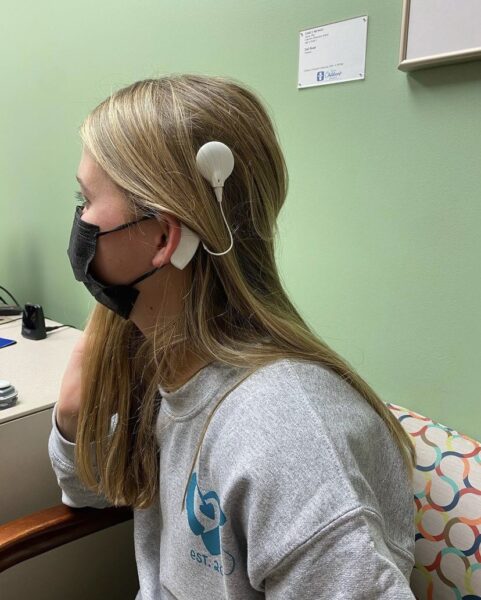
Kylie Porter, who would like to pursue a career as a pediatric audiologist, hopes to be an inspiration and role model for kids who are deaf and hard of hearing.
Dr. Maria Leno, an audiologist at Akron Children’s, does more than just help kids with hearing loss. In the case of 16-year-old high school sophomore Kylie Porter, she may have inspired a future career.
Born with Stickler syndrome, a group of hereditary conditions that can lead to eye abnormalities, hearing loss and joint problems, Kylie has worked with Dr. Leno since she was 11 years old and says she’s the reason she wants to pursue a career in pediatric audiology.
Kylie got her first set of hearing aids at 4 months old. Through the years, her hearing loss has become progressively worse.
“Kylie’s hearing in her left ear had become bad enough that she was having a hard time understanding people when there was a lot of background noise,” said Kylie’s mom, Amy. “But, if we turned up her hearing aids too much, speech and other sounds became distorted.”
According to Dr. Leno, as a years-long hearing aid user, Kylie was being monitored to see if she might become a candidate for a cochlear implant.

Kylie had cochlear implantation surgery in Nov. 2021. She only has the implant in one ear. Cochlear implants help improve the clarity of sound by sending clear auditory signals to an intact auditory nerve so speech can be understood.
“Candidates for a cochlear implant must go through a comprehensive evaluation process and must be fully committed to the process,” said Dr. Leno. “If a child gets a cochlear implant but never wears it, they won’t see any benefit. Cochlear implants must be worn during all waking hours for the brain to make the connection to this new way of hearing.”
Cochlear implants help improve the clarity of sound by sending clear auditory signals to an intact auditory nerve so speech can continue to be understood. They are made up of two parts: the external sound processor worn behind the ear and the internal implant.
“Microphones on the sound processor pick up the sound and convert it into a digital signal. The digital signal is then sent to the implant where it electrically stimulates the cochlea and auditory nerve,” said Dr. Leno. “The signal is then sent to the brain where it can be processed and understood as sound or speech.”
Dr. Leno said it’s impossible to predict the success an individual will experience after receiving a cochlear implant.

Kylie was diagnosed at birth with hearing loss. She has worn hearing aids since 4 months of age.
“Factors like shorter duration of severe hearing loss, access to sound during the critical language learning period via hearing aid, and a strong commitment from the family all contribute to greater success rates,” she said.
It’s important to note that not everyone with severe to profound hearing loss chooses cochlear implantation.
“Some people with severe to profound hearing loss choose American Sign Language as their mode of communication based on the needs of the family or their culture.,” said Dr. Leno.
After learning she was a good candidate for cochlear implantation in 2021, Kylie decided to move forward with the surgery.
“When they turned on the implant it wasn’t like turning on a light switch and she could suddenly hear,” said Amy.
Kylie said at first everything sounded like beeps and noises and voices sounded robotic.
“I had to learn how to listen and understand the new sounds from the implant,” said Kylie, who used auditory rehab apps on a tablet to help her brain acclimate and identify different sounds and voices. “It took almost 6 months of auditory therapy before I liked the way it sounded.”
Kylie still wears a hearing aid in her right ear.
“My hearing aid is good with lower pitch sounds and my implant is good with softer noise and higher pitches,” she said. “They balance each other out.”
Now 1 ½ years post implant, Kylie enjoys sharing her journey with hearing loss on her Instagram page @kylie_hearing_loss.

Kylie enjoys sharing her journey with hearing loss on her Instagram page. She uses the platform as a means to educate, advocate and create awareness around issues facing the deaf and hard of hearing community.
“At first, I just wanted to meet other teens like me,” she said. “But it expanded into advocacy for the deaf and hard of hearing population and spreading awareness.”
“Kylie has always impressed me,” said Dr. Leno. “She’s a strongly motivated teen who advocates for herself and her listening needs. She has worked hard to have success with her implant and shares the joys of her journey with others.”
Although she did not grow up using sign language, Kylie is now in her second year taking ASL in school, which may serve her well in her future career.
“I find pediatric audiology to be a very interesting field,” she said. “I want to work with kids so I can watch their growth and progress. I hope I can be a role model for them.”
To learn more about the cochlear implant program at Akron Children’s, visit akronchildrens.org.











